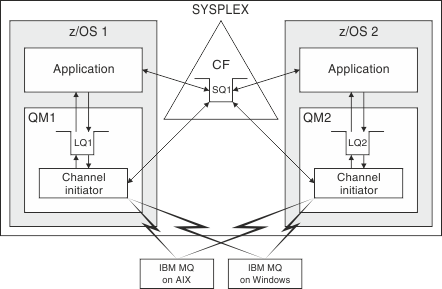Distributed queuing and queue sharing groups
Distributed queuing and queue sharing groups are two techniques used to increase the availability of the application systems. Use this topic to find further information about these techniques.
To complement the high availability of messages on shared queues, the distributed queuing component of IBM MQ has additional functions to provide the following:- Higher availability to the network.
- Increased capacity for inbound network connections to the queue sharing group.
Figure 1 illustrates distributed queuing and queue sharing groups. It
shows two queue managers within a sysplex, both of which belong to the same queue sharing group.
They can both access shared queue SQ1. Queue managers in the network (on AIX and Windows
for example) can put messages onto this queue through the channel initiator of either queue manager.
Cloned applications on both queue managers service the queue.

- Shared channels
Use this topic to understand the concepts of shared channels and their use with IBM MQ for z/OS. - Intra-group queuing
Intra-group queuing allows transfer of messages between queue managers in a queue sharing group. - Clusters and queue sharing groups
Use this topic to understand how we can use queue sharing groups with clusters.
Parent topic: Shared queues and queue sharing groups
Related concepts